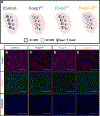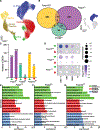Compensation between FOXP transcription factors maintains proper striatal function
- PMID: 38761373
- PMCID: PMC11234887
- DOI: 10.1016/j.celrep.2024.114257
Compensation between FOXP transcription factors maintains proper striatal function
Abstract
Spiny projection neurons (SPNs) of the striatum are critical in integrating neurochemical information to coordinate motor and reward-based behavior. Mutations in the regulatory transcription factors expressed in SPNs can result in neurodevelopmental disorders (NDDs). Paralogous transcription factors Foxp1 and Foxp2, which are both expressed in the dopamine receptor 1 (D1) expressing SPNs, are known to have variants implicated in NDDs. Utilizing mice with a D1-SPN-specific loss of Foxp1, Foxp2, or both and a combination of behavior, electrophysiology, and cell-type-specific genomic analysis, loss of both genes results in impaired motor and social behavior as well as increased firing of the D1-SPNs. Differential gene expression analysis implicates genes involved in autism risk, electrophysiological properties, and neuronal development and function. Viral-mediated re-expression of Foxp1 into the double knockouts is sufficient to restore electrophysiological and behavioral deficits. These data indicate complementary roles between Foxp1 and Foxp2 in the D1-SPNs.
Keywords: CP: Molecular biology; CP: Neuroscience; FOXP1; FOXP2; autism; neurogenomics; spiny projection neurons; striatum.
Copyright © 2024 The Author(s). Published by Elsevier Inc. All rights reserved.
Conflict of interest statement
Declaration of interests The authors declare no competing interests.
Figures







Update of
-
Compensation between FOXP transcription factors maintains proper striatal function.bioRxiv [Preprint]. 2023 Jun 26:2023.06.26.546567. doi: 10.1101/2023.06.26.546567. bioRxiv. 2023. Update in: Cell Rep. 2024 May 28;43(5):114257. doi: 10.1016/j.celrep.2024.114257. PMID: 37425820 Free PMC article. Updated. Preprint.
Similar articles
-
Compensation between FOXP transcription factors maintains proper striatal function.bioRxiv [Preprint]. 2023 Jun 26:2023.06.26.546567. doi: 10.1101/2023.06.26.546567. bioRxiv. 2023. Update in: Cell Rep. 2024 May 28;43(5):114257. doi: 10.1016/j.celrep.2024.114257. PMID: 37425820 Free PMC article. Updated. Preprint.
-
Differential and Overlapping Pattern of Foxp1 and Foxp2 Expression in the Striatum of Adult Mouse Brain.Neuroscience. 2018 Sep 15;388:214-223. doi: 10.1016/j.neuroscience.2018.07.017. Epub 2018 Jul 19. Neuroscience. 2018. PMID: 30031127
-
FOXP1 negatively regulates intrinsic excitability in D2 striatal projection neurons by promoting inwardly rectifying and leak potassium currents.Mol Psychiatry. 2021 Jun;26(6):1761-1774. doi: 10.1038/s41380-020-00995-x. Epub 2021 Jan 5. Mol Psychiatry. 2021. PMID: 33402705 Free PMC article.
-
The distinct and overlapping phenotypic spectra of FOXP1 and FOXP2 in cognitive disorders.Hum Genet. 2012 Nov;131(11):1687-98. doi: 10.1007/s00439-012-1193-z. Epub 2012 Jun 27. Hum Genet. 2012. PMID: 22736078 Free PMC article. Review.
-
From Signaling Molecules to Circuits and Behaviors: Cell-Type-Specific Adaptations to Psychostimulant Exposure in the Striatum.Biol Psychiatry. 2020 Jun 1;87(11):944-953. doi: 10.1016/j.biopsych.2019.11.001. Epub 2019 Nov 9. Biol Psychiatry. 2020. PMID: 31928716 Review.
Cited by
-
The dopamine hypothesis for ADHD: An evaluation of evidence accumulated from human studies and animal models.Front Psychiatry. 2024 Nov 15;15:1492126. doi: 10.3389/fpsyt.2024.1492126. eCollection 2024. Front Psychiatry. 2024. PMID: 39619336 Free PMC article. Review.
-
CtBP1 is essential for epigenetic silencing of μ-opioid receptor genes in the dorsal root ganglion in spinal nerve ligation-induced neuropathic pain.Neurotherapeutics. 2025 Jan;22(1):e00493. doi: 10.1016/j.neurot.2024.e00493. Epub 2024 Nov 22. Neurotherapeutics. 2025. PMID: 39580324 Free PMC article.
-
Multiplexed CRISPRi Reveals a Transcriptional Switch Between KLF Activators and Repressors in the Maturing Neocortex.bioRxiv [Preprint]. 2025 Feb 15:2025.02.07.636951. doi: 10.1101/2025.02.07.636951. bioRxiv. 2025. PMID: 39975013 Free PMC article. Preprint.
-
Spatial dynamics of mammalian brain development and neuroinflammation by multimodal tri-omics mapping.bioRxiv [Preprint]. 2024 Jul 28:2024.07.28.605493. doi: 10.1101/2024.07.28.605493. bioRxiv. 2024. PMID: 39091821 Free PMC article. Preprint.
References
-
- Gerfen CR (1992). The neostriatal mosaic: multiple levels of compartmental organization. Trends Neurosci. 15, 133–139. - PubMed
MeSH terms
Substances
Grants and funding
LinkOut - more resources
Full Text Sources
Molecular Biology Databases
Research Materials
Miscellaneous

